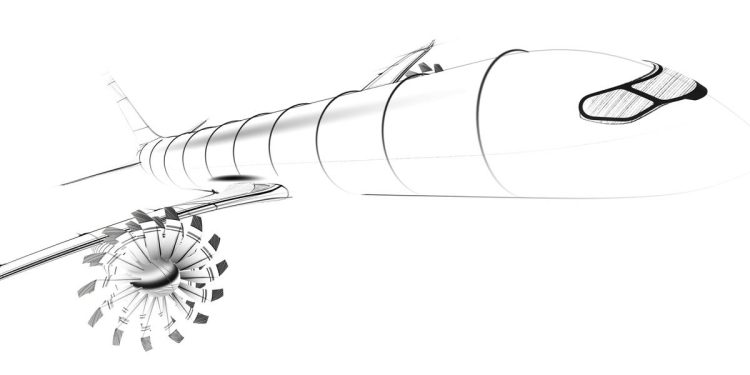While Airbus has rejected the plans for a hydrogen planIt plans to build a high -tech plane which is cheaper and more respectful of the environment.
Business Insider looked at the technology that could drive it.
During its recent summit at its headquarters Toulouse, France, CEO Guillaume Faury Journalists said that he developed a new unique plane to succeed his A320 family and enter the second half of the 2030s.
He said that the plan powered by hydrogen had been canceled because it risked being “a hydrogen concord” and not commercially viable on a large scale.
He said that a new generation plane would not be delivered with an “incremental optimization” but “leaf conceptions”. He also predicted a “glove-off” competition to build a new generation plane with the American Rival of Airbus Boeing.
This is the new technology it develops.
Open fans engines
Airbus and CFM provide for the flight tests open on the A380 by 2030. Pete Syme / Bi
A higher energy efficiency is a major discussion point in aviation, but making it will require “a fundamental change in the form of the engine,” said Mohamed Ali, head of technology and operations of Ge Aerospace.
Turbofan jet engines work by taking air. Part of this air enters the engine nucleus where it is mixed with fuel and combustions to drive turbines. The rest of the air is accelerated by the fan and bypasses the nucleus.
The engines that have a higher proportion of bypass air are more fuel economical. However, this report is limited by the size of the intake duct.
“Here is the solution, and this is the beauty of physics. You can delete this conduit and go to the opening of the fan,” said Ali.
Although the engines of today have a derivation ratio of up to 12: 1, Ali said that the current conceptions of an open canette engine would improve this at 60: 1.
Airbus and CFM – A joint venture between GE and Safran – plan to test open cannon engines on an Airbus A380 at the end of the decade.
They also provide that new engines can work entirely with sustainable aviation fuel. This can be produced from plants and cooking oil, but its plug has so far been hampered by high costs and a lack of availability.
Folding wings
A Wing of Tomorrow model exposed to the Airbus summit. Pete Syme / Bi
Airbus engineers are looking for longer wings to create more lifting and reduce the drag, which means in turn using less fuel. However, the size of the wings of an aircraft is limited by the size of the airport doors.
However, if the wing terminals can bend, planes can always have longer wings in flight and adapt to the doors of airport on the ground.
If it seems familiar, you may have seen something similar on the next Boeing 777X, although IIRBUS first plans to use it on narrow body planes.
“If you are thinking of the next generation of planes in Monocyto, he will fly several times a day, 24 hours a day, 7 days a week,” said Sue Partridge, head of the Wing of Tomorrow program. “This folding wing system must operate reliably.”
New materials and a certain automation
Another step forward in energy efficiency could be found in new composite materials.
The latest generation of line aircraft, such as the Airbus A350 and the Boeing 787, uses reinforced carbon fiber polymers in the wings and the fuselage. These are stronger and lighter than aluminum, but more advances could be made.
“We are working on the next generation of composite materials, our suppliers of materials working as a partners with us,” said Parridge at the top.
Just before the start of the summit, Reuters reported that the two planmemakers are considering thermoplastics for future planes.
Monomore planes are more popular than Widebodies, with Airbus plans to produce 75 per month.
“We must be able to manufacture our planes and our wings at a high rate and at a cost which is in fact durable for our company,” said Partridge.
She added that the Wing of Tomorrow program was considering robotic and automation technologies to see how they could speed up manufacturing.
However, automation will not take place in factories.
At the top, BI is mounted in an autonomous van testing Airbus’s new autonomous technology, an opposite.
He tested the cameras, the radar and the Lidar to help follow the airport lines for the autonomous taxi and to avoid potential collisions. Miss relatives have been increasingly common in recent years, and Airbus also plans that there will be twice as many aircraft in 20 years.
AI could also be used to predict traffic and help pilots redirect turbulence or bad weather.
The Airbus optical van uses the Lidar and the cameras. Pete Syme / Bi
Even more than 10 years ago before Iirbus saw his next generation of planes adopting the sky.
Faury, the CEO, compared the process to “a caterpillar in a cocoon becoming a butterfly”.
“In this transition, there is a little paralysis,” he said. “There is a lot of strength at stake, it’s painful, then the butterfly takes off. We don’t know what it looks like until we are there.”
“We remain attached to our goal, which is a pioneer of the sustainable aerospace for a safe and united world,” he added. “We think it’s a beautiful goal, but it’s not easy.”
businessinsider



